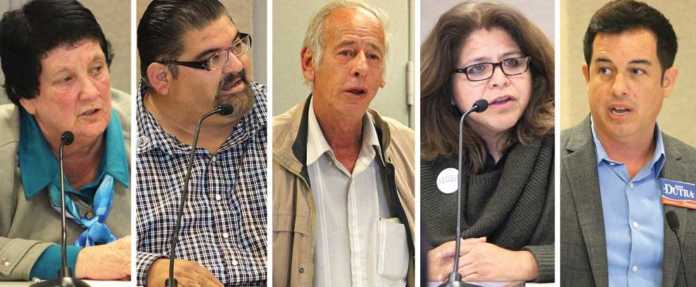(Nancy Bilicich (from left), Felipe Hernandez, Greg Caput, Leticia Mendoza and Jimmy Dutra are vying for the District 4 seat on the Santa Cruz County Board of Supervisors. Photos by Erik Chalhoub/Pajaronian)
WATSONVILLE — The five candidates for the Fourth District seat on the Santa Cruz County Board of Supervisors spoke about their vision for South County during a forum Tuesday evening.
Current Watsonville City Council members Nancy Bilicich, Jimmy Dutra and Felipe Hernandez are joined by Watsonville YWCA Executive Director Leticia Mendoza in facing off against incumbent Greg Caput in the June 5 election.
The candidates touched on topics such as housing, transportation, homelessness and cannabis during the two-hour forum, put on by the Santa Cruz County Business Council and the Pajaro Valley Chamber of Commerce and Agriculture in the Watsonville Civic Plaza Community Room.
Santa Cruz County’s Fourth District ranges from Hazel Dell and Mount Madonna roads to the north, the Pajaro River to the south, Green Valley Road and Airport Boulevard to the west and the Santa Cruz County border line in Mount Madonna and Aromas to the east.
•••
Transportation
The Santa Cruz County Regional Transportation Commission is currently studying a number of projects that could be made on three parallel routes in the county: Highway 1, Soquel Avenue/Drive and Freedom Boulevard, and the Santa Cruz Branch Rail Line.
The scenarios include a trail only on the rail line, a rail with trail, a bus rapid transit with trail, and a rail with trail including freight.
A “no build” scenario is also listed on the study.
Bilicich said she supports a light rail passenger service along the Santa Cruz Branch Line as a way to alleviate gridlock along Highway 1. She advised that there needs to be a “well thought out plan” for a multi-use trail alongside the rail line.
“It’s not working with just cars,” she said. “We need to have alternatives, and convenient alternatives.”
Since the study still hasn’t been finalized, Dutra said he would wait to read the draft report and give an answer then.
“We need to make sure that whatever goes in there, it’s the right thing for our community,” he said.
Hernandez said commuter service needs to be pursued, as well as other options such as a lane on Highway 1 for high occupancy vehicles, more shuttle programs and others. He added that Highway 1 should be renamed “Parking Lot 1,” and parents are faced with increased childcare costs because it takes them longer to travel home.
“Everyday my constituents tell me they are stuck on the highway and it affects their quality of life,” Hernandez said. “Our population is growing, and that means more commuters.”
Mendoza said the rail line cannot only be looked at as a mode of transportation, but also an economic driver. She cautioned that Santa Cruz County could become a “dormitory city,” where residents would take the train out of the county to commute to work.
“I believe it is important to have an alternative mode of transportation, but we also have to look at the real impact,” she said.
When the county purchased the Santa Cruz Branch Line in 2012, the intent was to one day include passenger rail service, according to Caput. To not pursue passenger service would be a misuse of taxpayer funds, he said.
“I want to see expanded bus lines, along with the rail and trail,” Caput said. “We have to include all of them, and make sure Watsonville is part of it.”
•••
Homelessness
Caput said he has donated more than $30,000 of his wages over the past few years to help Teen Challenge and Pajaro Rescue Mission run a winter shelter in Watsonville. While shelters and mental health facilities play a crucial role in helping homeless people, programs such as CalFresh are vital to prevent people from becoming homeless in the first place, he added.
“We have to help prevent homelessness, and also deal with the reality of homelessness,” Caput said.
Mendoza said nonprofits and the county need to coordinate efforts to tackle homelessness. Too often, she noted, organizations work separately to solve a problem.
“If we work together, we can have better outcomes, rather than working individually,” Mendoza said.
Cleaning up homeless encampments is not a sustainable practice, Hernandez said. Instead, the county needs to create a “comprehensive plan that breaks the cycle,” he said, that makes sure programs that prevent drug and alcohol abuse are well-funded.
“We need to bring our nonprofits together to assist in our efforts,” Hernandez said. “This is a regional issue, and we need to address it as a region.”
Dutra said the county needs to hire a person whose job is to deal directly with the homeless people living in the sloughs and other areas. Local nonprofits, such as Pajaro Valley Shelter Services and Community Action Board, are helping with the situation, but the county needs to create a partnership with them to address the issue, he said.
“A lot of nonprofits in our city are working really hard to fix this,” Dutra said. “We need the county to step up and be visible.”
Bilicich agreed that the county needs to work together with area nonprofits, but she said it also needs to understand why people are homeless, and what it can do to help them.
“We make assumptions, but we need to listen,” she said. “Is it a mental health issue? Do they need job training skills? We need to set short-term goals so they can be productive members of society.”
•••
Latest fundraising numbers released
Hernandez surged in the latest round of campaign fundraising in the District 4 race, finance statements show.
From Jan. 1 to April 21, Hernandez raised $15,486, up from the $3,966 he raised in the previous six months.
Bilicich raised $14,948, which included a $7,000 loan from herself to her campaign. Mendoza brought in $12,696, including $6,156 in loans, while Caput raised $11,408.
Dutra raised $4,859 during the more than three-month period. After a strong start in the previous round of fundraising, Dutra still leads all candidates with a $18,185.64 cash balance.
The largest contributions Hernandez received during the period were $1,000 each from the Pipe Trades District Council #36 PAC and the Political Action League for Monterey/Santa Cruz Building and Construction Trades Council. Among his expenditures, Hernandez spent $3,222.82 to CandidateSigns.com/Heartland Signs, Inc. for campaign signs.
Contributors to Bilicich’s, Caput’s and Mendoza’s campaigns were largely retired residents.
Bilicich’s largest expenditure was to Alex Hulanicki of Salinas of $10,000 for campaign consulting.
Among his expenditures, Caput spent $1,638 to Pajaro Valley Printing for lawn signs.
Most of Mendoza’s campaign expenditures were reimbursements to herself for postage and signs, including $2,837 for candidate filing fees.
Dutra’s largest contribution was $800 from the Bay Area Municipal Election Committee. His expenditures included $1,137.84 to Pajaro Valley Printing and $1,901.82 to VictoryStore.com for campaign paraphernalia.












